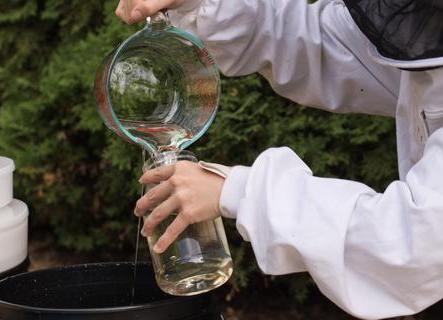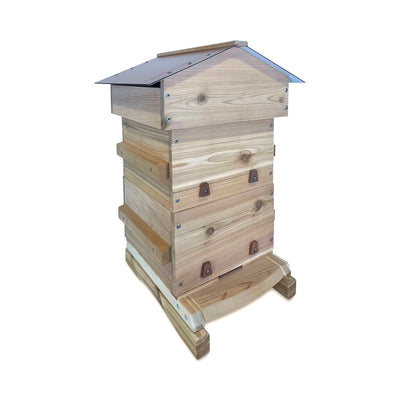When and How to Feed Your Bees
To feed or not to feed? Arguably one of the toughest questions to answer as a beekeeper, but fear not! We’re ready to share a wealth of information that should help you navigate this tricky topic.
 Feeding is a somewhat controversial topic in the beekeeping field. A darwinian beekeeping philosophy does not support feeding your bees at all. This would cause bees with weak genetics to die out over the winter and be replaced by a strong colony splitting in two in the spring. That being said, there are some extenuating circumstances that may leave beekeepers with no choice but to feed. For example, if a summer forest fire wipes out bee forage for the season, an otherwise genetically-strong colony would not have the resources to make enough honey stores for the winter. When these circumstances arise, beekeepers who would not otherwise feed may choose to do so to support the survival of their bees.
Feeding is a somewhat controversial topic in the beekeeping field. A darwinian beekeeping philosophy does not support feeding your bees at all. This would cause bees with weak genetics to die out over the winter and be replaced by a strong colony splitting in two in the spring. That being said, there are some extenuating circumstances that may leave beekeepers with no choice but to feed. For example, if a summer forest fire wipes out bee forage for the season, an otherwise genetically-strong colony would not have the resources to make enough honey stores for the winter. When these circumstances arise, beekeepers who would not otherwise feed may choose to do so to support the survival of their bees.
How do I know if I should feed?
There is no one-size-fits-all answer to this question. There are so many factors to consider when making this decision! Climate, honey-to-brood ratio and your bees specific strain will all affect whether or not they’ll be able to survive off their honey stores. In general, we like to say that your colony should have honey stores that are about equal to their brood stores, but of course this depends. Read up on the specific strain of your bees to learn more the climate they were bred for and how this will affect their behavior. Italian bees, for example, are bred for short winters and thus, tend to eat through their honey stores too quickly when living in a colder climate. Read up on your bees’ specific strain, factor in your climate, and talk to other local beekeepers to create an effective plan.
When should I feed?
If you decide to feed your bees, you will need to do so before winter arrives, because bees will not drink liquid feed when it is below 50 degrees Fahrenheit. Don’t forget that you can also support your bees’ diet by providing plenty of late season foraging, which we discuss in more detail in our Late Season Planting for Pollinators video and blog post. Being proactive is important!
How do I make feed?
At this time of the year, you’ll want to use two cups of sugar for every one cup of warm water. Remember to use white granulated sugar, not brown or raw sugar. Bees cannot properly digest dark sugars! You can also add a pinch of a crushed up Vitamin C tab to the mixture, because nectar is naturally more acidic than simple sugar syrup.
What kind of feeder should I use, and how do I use it?
There are many different types of feeders to choose from, and different hive designs require different feeders. Here at Bee Built, we offer a double jar feeder, a round hive top feeder, and a gallon hive top feeder. In a Langstroth Hive, place your inner cover over the top-most box that your bees are occupying. Set the feeder over the hole in the inner cover and surround it with an empty box followed by your outer cover. Alternatively, you can use an entrance feeder by sliding it into the entrance of your hive. While you can use any of our feeders for a 10-frame Langstroth, the gallon hive top feeder is too wide for an 8-frame hive.
In a Langstroth Hive, place your inner cover over the top-most box that your bees are occupying. Set the feeder over the hole in the inner cover and surround it with an empty box followed by your outer cover. Alternatively, you can use an entrance feeder by sliding it into the entrance of your hive. While you can use any of our feeders for a 10-frame Langstroth, the gallon hive top feeder is too wide for an 8-frame hive.
In a Warre hive, cut a flap in your separator canvas the size of your feeder. Put it back in place on your top bars and fold the flap back. Place the feeder over the cut-out you made. Enclose the feeder with an empty hive box, and put your quilt box and roof back in place. For Warre hives, you can use a double jar feeder or a round hive top feeder.

In a top bar hive, place the feeder in the empty cavity of the hive body. You can prop the divider board up with sticks, or drill cork-sized holes in the bottom for your bees to crawl through. Place the feeder in the bottom of the empty cavity and place empty top bars back on top. You can use a double jar feeder or a round hive top feeder depending on the width of your bottom. The new Bee Built top bar hive can accept either feeder type.

No matter what type of feeder you choose, deciding to feed your bees in the late summer could ultimately save the colony. Good luck!
For even more information, check out this video we made as a part of our Overwintering Series:






Leave a comment